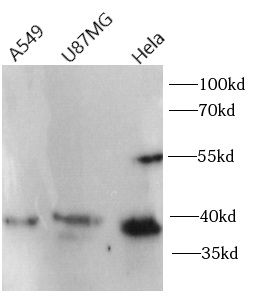Products
CXCR4 antibody
Category:
| Synonyms: | CD184 antibody, CXC R4 antibody, CXCR 4 antibody, CXCR4 antibody, CXCR4B antibody, D2S201E antibody, FB22 antibody, Fusin antibody, HM89 antibody, HSY3RR antibody, LAP3 antibody, LCR1 antibody, LESTR antibody, SDF 1 receptor antibody, WHIM antibody | ||
| Catalogue No.: | FNab10437 | Reactivity: | Human,Rat |
| Host: | Rabbit | Tested Application: | ELISA, WB, IHC |
| Clonality: | polyclonal | Isotype: | IgG |
- SPECIFICATIONS
- Product Name
- CXCR4 antibody
- Catalogue No.
- FNab10437
- Size
- 100μg
- Form
- liquid
- Purification
- Immunogen affinity purified
- Purity
- ≥95% as determined by SDS-PAGE
- Clonality
- polyclonal
- Isotype
- IgG
- Storage
- PBS with 0.02% sodium azide and 50% glycerol pH 7.3, -20℃ for 12 months (Avoid repeated freeze / thaw cycles.)
Immunogen
- Immunogen
- chemokine (C-X-C motif) receptor 4
- Alternative Names
- CD184 antibody, CXC R4 antibody, CXCR 4 antibody, CXCR4 antibody, CXCR4B antibody, D2S201E antibody, FB22 antibody, Fusin antibody, HM89 antibody, HSY3RR antibody, LAP3 antibody, LCR1 antibody, LESTR antibody, SDF 1 receptor antibody, WHIM antibody
- UniProt ID
- P61073
- Observed MW
- 40 kDa, 55 kDa
Application
- Tested Applications
- ELISA, WB, IHC
- Recommended dilution
- WB: 1:500-1:2000; IHC: 1:20-1:200
Validated Images
 Various lysates were subjected to SDS PAGE followed by western blot with FNab10437(CXCR4 Antibody) at dilution of 1:1000
Various lysates were subjected to SDS PAGE followed by western blot with FNab10437(CXCR4 Antibody) at dilution of 1:1000
 Immunohistochemistry of paraffin-embedded rat brain tissue slide using FNab10437(CXCR4 Antibody) at dilution of 1:50
Immunohistochemistry of paraffin-embedded rat brain tissue slide using FNab10437(CXCR4 Antibody) at dilution of 1:50
- Background
- C-X-C chemokine receptor type 4 (CXCR4) is a widely expressed G protein-coupled seven-transmembrane receptor. CXCL12/SDF-1 is the biological ligand for CXCR4. The binding of CXCL12 to CXCR4 induces intracellular signaling through several divergent pathways initiating signals related to chemotaxis, cell survival and/or proliferation, increase in intracellular calcium, and gene transcription (PMID: 20484021). CXCR4 also functions as a coreceptor for HIV-1 entry (PMID: 9427609). CXCR4 has a calculated molecular weight of 40 kDa. In addition to the predicted species of 45-47 kDa for glycosylated CXCR4 monomers, due to ubiquitination, dimeration, and different degrees of glycosylation, additional species can also exist and have been reported in some researches, including 67 kDa (PMID: 23917520), 55, 67, 87 kDa (PMID: 20028517), 80 kDa (PMID: 10506573), 47, 50, 62, and 98 kDa (PMID: 16204649).



